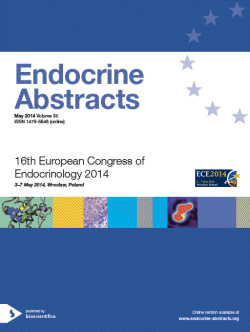Oral Communications
Pituitary Basic
ea0035oc12.1 | Pituitary Basic | ECE2014
Human AIP gene rescue lethality in a Drosophila melanogaster knockout model of AIP orthologue
Aflorei Elena Daniela , Chen Chenghao , Klapholz Benjamin , Brown Nick , Stanewsky Ralf , Korbonits Marta
ea0035oc12.2 | Pituitary Basic | ECE2014
Differential in vitro response to octreotide and pasireotide in normal and tumoral primary pituitary cell cultures
Ibanez-Costa Alejandro , Gahete Manuel David , Jimenez-Reina Luis , Rivero-Cortes Esther , Lopez-Sanchez Laura Maria , Galvez Maria Angeles , de la Riva Andres , Benito-Lopez Pedro , Venegas-Moreno Eva , Angel Japon Miguel , Moreno Alberto , Garcia-Arnes Juan Antonio , Maraver-Selfa Silvia , Angel Arraez Miguel , Leal-Cerro Alfonso , Schmid Herbert A. , Tinahones Francisco J. , Soto-Moreno Alfonso , Castano Justo P. , Luque Raul M.
ea0035oc12.3 | Pituitary Basic | ECE2014
Detection of pituitary antibodies by immunofluorescence: Methodological approach and results in patients with pituitary diseases
Ricciuti Adriana , De Remigis Alessandra , Landek-Salgado Melissa A. , De Vincentiis Ludovica , Guaraldi Federica , Lupi Isabella , Iwama Shintaro , Wand Gary S. , Salvatori Roberto , Caturegli Patrizio
ea0035oc12.4 | Pituitary Basic | ECE2014
Identification and characterization of pituitary adenoma stem-like cells in human non functioning pituitary adenomas
Giardino Elena , Peverelli Erika , Treppiedi Donatella , Belicchi Marzia , Meregalli Mirella , Spada Anna , Torrente Yvan , Mantovani Giovanna
ea0035oc12.5 | Pituitary Basic | ECE2014
Does hypercortisolism of Cushing’s syndrome affect telomere length?
Aulinas Anna , Ramirez Maria Jose , Barahona Maria Jose , Valassi Elena , Resmini Eugenia , Mato Eugenia , Santos Alicia , Crespo Iris , Bell Olga , Surralles Jordi , Webb Susan




